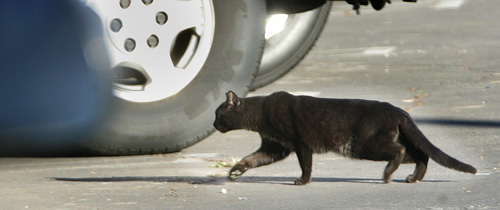
A feral cat slinks through the parking lot of the LAPD's Southeast Division.
Picture by Bob Chamberlin / LA Times.
The LA police department is hiring feral cats to protect police stations... from rodents! Feral cats don't make great pets, so when they're caught they're usually killed. But, they're great at hanging around and scaring away rats. And, they work for room and board.

It takes work getting a feral cat acclimatized to a new location. You have to keep them caged up, since at first they'll do whatever they can to get back to their old place. After about 30 days, they'll settle in.LAPD enlists feral cats for rat patrol
Carla Hall, Los Angeles Times Staff Writer
December 29, 2007
They are the homeless of the domestic animal world — colonies of feral cats that roam residential neighborhoods and lurk around office buildings and commercial garages, scavenging for food.
Unlike other strays that might rub up against a leg hoping for a crumb or a head rub, these felines are so unaccustomed to human contact that they dart away when people approach. Feral cats cannot be turned into house pets. When they end up in municipal shelters, they have little hope of coming out alive.
But one animal welfare group has figured out a way to save their lives and put them to work in Los Angeles. The Working Cats program of Voice for the Animals, a Los Angeles-based animal advocacy and rescue group, has placed feral cats in a handful of police stations with rodent problems, just as the group placed cats in the rat-plagued downtown flower district several years ago -- to great effect.
Six feral cats were recently installed as ratters in the parking lot of the Los Angeles Police Department's Southeast Division, and another group will be housed at the Central Division early in the new year.
Their reputation as furtive and successful exterminators grew after feral cats were introduced to the parking lot of the Wilshire Division nearly six years ago. Rats had been burrowing into the equipment bags that bicycle officers stored in outside cages; inside the facility, mice were sometimes scurrying across people's desks.
"Once we got the cats, problem solved," said Cmdr. Kirk Albanese, a captain at the Wilshire station at the time. "I was almost an immediate believer."
After Albanese moved to the Foothill Division in the northern San Fernando Valley, he introduced feral cats to the building's mice-infested basement in 2004.
"I think it's a very humane way to deal with a very stubborn problem," said Albanese, now assistant to the director in the office of operations at Parker Center, which has its own rat problem.
The cats don't generally solve the rodent problem by killing rats and mice — although the cats are game for doing so if they catch them. Rather, the cats simply leave their scent. Once rodents get a whiff of feline presence, like gangsters under a gang injunction, they move on.
[...]
On the other side of the eternal cat-mouse battle, the big new development is genetically engineered "marathon mice" that can run much longer than an ordinary mouse and doesn't need to exercise to stay physically fit!
There seem to be a couple of different strains of marathon mice. The first was developed by Ronald Evans of the Salk Institute in 2004, and involved getting a gene to create more PPARδ, a regulator that affects metabolism in fatty cells. Somehow this resulted in a dramatic increase of "slow twitch" muscle fibers, the kind that don't get tired.
Of course, the serious side of the marathon mouse is what it will mean
for genetic engineering of people.
January 4, 2008
One of our gates was ripped off its hinges during the last
big windstorm. Now
they say
we're in for a lot of rain: up to a
foot in places (not here), and maybe ten feet of snow in the Sierras.
This could really ease the drought in a serious way. In the burnt
hills, people are preparing for mud slides.
The rain is supposed to hit this evening — and before it, more
high winds. I'd better take the trash bins in, so we don't
have garbage blowing everywhere. It's a good day to clean out the gutters,
too!
January 7, 2008
It didn't help: the gutters in front of the house fell down.
More repairs.
But, it snowed a lot in the mountains, and the hills are turning green, making for some pretty views. Lisa and I took a hike in Box Springs Park, pretty close to our house, starting from the Two Trees entrance. Lisa took these photos:

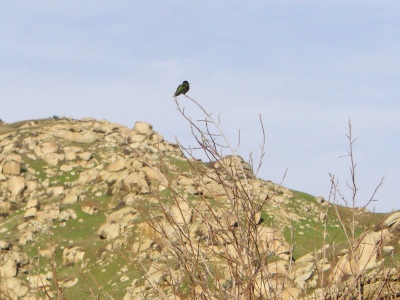

Here's the story: the struggles of a mathematician who's juggling too many balls at once.
I've been working on a paper with Danny Stevenson, The Classifying Space of a Topological 2-Group, leading up to the construction of characteristic classes for certain 2-bundles. I'd also been committed to finish a paper for the Abel Symposium conference proceeedings by this month or the next. In December I cleverly realized I could kill two birds with one stone by making these the same paper, instead of writing a separate expository paper for the Abel Symposium, as I'd been planning. By now this paper with Danny is almost done, but there are some niggling technical details left to straighten out. I'm way too busy to sit and think about these with the attention they deserve, but Danny seems to be figuring them out very nicely — when he gets ahold of a tough technical problem, he doesn't let it go until it's solved! I hope to get at least a first version on the arXiv in a week or less.
So, that'll be two papers off my list, using some clever bookkeeping.
I've also been working on a paper with Aaron Lauda, called A Prehistory of n-Categorical Physics. This had been slated to appear in the proceedings of a conference Peter May and I ran at the IMA in the summer of 2004: n-Categories: Foundations and Applications. This proceedings has been coming to fruition very slowly. It's partially my fault, but luckily I can blame André Joyal, since he's writing a huge introduction to quasicategories, the centerpiece of the whole volume, which has taken forever to finish. I also have another paper in this conference proceedings, thankfully finished: Lectures on n-Categories and Cohomology, with Mike Schulman. I suddenly realized that I don't need two papers in this proceedings — and that it might even look bad to have more than one papers in a volume I'm editing. So, I got Peter and Aaron's permission to pull out the Prehistory and place it in the proceedings for Deep Beauty: Mathematical Innovation and the Search for an Underlying Intelligibility of the Quantum World, a conference that Han Halvorson ran this fall. I sort of had to write a paper for that, since I was the "keynote speaker". I checked with Halvorson, and he said he liked the Prehistory. Indeed, it fits the theme of his conference better than it fits the IMA proceedings. I'm almost done with it, but now I have more time to finish it — it's due in the fall.
So, one more paper off my list, and one almost done, to be finished by autumn.
I'm also working on a paper with Mike Stay: Physics, Topology, Logic and Computation: A Rosetta Stone. This is due by mid-February for a volume Bob Coecke is compiling on "new structures in physics". I'm finally in a position to work hard on this, and it should go quick. I should be working on it right now! But, I'll burn out if I work all the time.
When that one is done, I'll have a bit of a breather.
There's a paper I'm writing with Laurent Freidel, Aristide Baratin and Derek Wise, Representations of 2-Groups. Luckily, my coauthors all seem quite distracted, so I don't feel under much pressure just now.
There's also a paper I need to finish for a volume on mathematics and narrative, Why Mathematics is Boring. I'm probably behind on this, but they haven't been pestering me.
I hope I can finish one of these two by September, along with the Prehistory, because then I'm giving a series of three lectures in Glasgow — the Robert Rankin Lectures. The Glasgow Mathematical Journal Trust will provide someone to transcribe these, and then I'll be stuck with the job of turning those transcripts into nice papers. That's always harder than it seems, since a good talk should contain much less information than a good paper. But, it's a good opportunity to try something fun, so I've decided to speak on My Favorite Numbers. The three lectures will be titled simply 5, 8 and 24. They'll cover a lot of curious special properties of these numbers. Someday I'd like to write a book on these theme, with each chapter covering a number: 0, 1, 2, 3, 4, 5, 6, 7,... eventually skipping some of the less interesting ones. However, I have more ideas for projects than time to do them, so this book may never get written.
There are also some papers I'm writing with grad students — but
I don't feel nearly as worried about these, because it's they
who must finish these papers or pay the price.
![]() These days I
meet with all my students for a mammoth session every Wednesday.
We spend most of that time talking math, but as they get further
along, the balance is shifting towards work on papers. Alex Hoffnung
is close to finishing one called Chen Spaces: A Convenient Category
for Differential Geometry (or something like that). He also has
a followup in the works, on connections and smooth anafunctors.
And, he and Chris Rogers have made a lot of progress on a paper
about categorifying classical mechanics. John Huerta will eventually
start working on a paper about the algebraic structure of grand unified
theories — we've got the ideas worked out; he just needs to
start writing. And, later, Christopher Walker should write something
about the categorified q-deformed harmonic oscillator (a topic of
this quarter's seminar).
These days I
meet with all my students for a mammoth session every Wednesday.
We spend most of that time talking math, but as they get further
along, the balance is shifting towards work on papers. Alex Hoffnung
is close to finishing one called Chen Spaces: A Convenient Category
for Differential Geometry (or something like that). He also has
a followup in the works, on connections and smooth anafunctors.
And, he and Chris Rogers have made a lot of progress on a paper
about categorifying classical mechanics. John Huerta will eventually
start working on a paper about the algebraic structure of grand unified
theories — we've got the ideas worked out; he just needs to
start writing. And, later, Christopher Walker should write something
about the categorified q-deformed harmonic oscillator (a topic of
this quarter's seminar).
I also have another paper on the back burner: Higher-Dimensional Algebra VII: Groupoidification. But, I want to give this one enough time to cook nicely.
So — lots of stuff! I felt it as a crushing burden
this fall, but now I'm chipping away at it nicely. The math,
of course, is delightful. It's just the feeling of "deadlines"
and "duties" that I have trouble with.
January 19, 2008
I've been getting into jazz more lately. I've always liked
some jazz, but now I'm getting a bit more serious
about it. For example: I have
Workin', Cookin' and Relaxin' by Miles
Davis' first quintet,
but now I feel the need to get Steamin' — the
last of this marvelous series of albums, all made on two days:
May 11 and October 26, 1956.
They feature an almost unbeatable lineup:
Miles Davis on trumpet,
John Coltrane on tenor sax,
Red Garland on piano,
Paul Chambers on bass,
and Philly Joe Jones on drums.
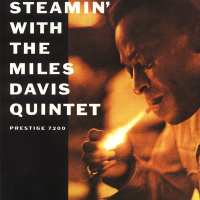
It's amazing how they cranked out so much good music in such a short time, but this is what a group of stellar musicians can do after playing together for years!
In fact, I've been getting pretty obsessed by Miles Davis, up to somewhere around Bitches Brew — everyone seems to lose interest in him past some point, and that's probably it for me. (I find Bitches Brew fascinating but not actually much fun to listen to; later he seemed to go flaccid, perhaps from too much cocaine.) His first quintet is great, but his second quintet really blows my mind. Those melodies by Wayne Shorter are so elliptical, evocative, mysterious....
I'm also getting into Coltrane. He's one of those names you hear mentioned with a strange awe, as if he's more respected than enjoyed. I'm finally overcoming the strange distaste this caused in me, and listening to his stuff. Naturally, it's great. Besides his work with Davis, I've been enjoying Lush Life and Blue Train.

Today I got A Love Supreme — again, one of those things I'd heard about so often that I was somehow unwilling to try it. Also the 8th edition of the Penguin Guide to Jazz Recordings. I like jazz now with almost the same passion I had for rock as a kid... but jazz is music for grownups: more sophisticated harmonically and rhythmically, just as adventurous at its best, always pushing the limits, but with a subtler, gentler spirit.
Mind you, I still like rock! It's not about
growing out of old things; it's about growing into new ones.
January 24, 2008
Yay! Danny and I finished our paper The Classifying Space of a Topological
2-Group. It's good to be working myself out of the
paper jam I'd gotten into.
Now I'm turning to the Rosetta
Stone paper with Mike Stay. Time to think about logic.
On a wholly different note — this rings so true:
The latest outrage continues: the head of the so-called "Environmental Protection Agency", Stephen Johnson, is trying to cover up the procedure (or lack of it) that led him to forbid 15 states the ability to cut automobile exhaust emissions:A National Near-Death Experience
We're getting closer to the light — the one at the end of the George Bush tunnel.
Patt Morrison, LA Times.
January 24, 2008
One year from this very moment, someone other than George Bush will be sliding behind that antique desk in the Oval Office. In embassies and outposts that fly the Stars and Stripes, photographs of a face other than Bush's will be going up on the walls.
At long, long last. It is seven years since Bush plopped down behind that desk, seven years when hope and honor and good faith and goodwill died a little for me, for many other heartsick Americans who love this country, and for millions around the world who looked up to this country.
I say "died," and I mean that. The psychiatrist Elisabeth Kubler-Ross laid out the basic stages of grief and coming to terms with loss. And Kubler-Ross' five stages track almost perfectly the arc of how we've grappled and grieved over the sickening power crusade of the Bush administration against the nation for these last seven years.
Denial: It can't be happening. Who could expect that the man who had to win election in court, not at the polls, would instantly, arrogantly go on the attack — wiping out environmental protections unmatched since Teddy Roosevelt, throwing out scores of health and safety and accountability and privacy rules and protections that made life better for typical Americans, and making "caveat emptor" the only motto of U.S. business? There must be some mistake, doctor.
Anger: It's not fair. How dare they? How can they practice retrograde isolationism abroad and rapacious cronyism at home? How can they dishonor 9/11 by exploiting the nation's fears to justify upending the Constitution and creating a metastasized secret government? Threatening librarians with prosecution? Arresting people wearing anti-Bush T-shirts, thus conflating protest with sedition? Sneaking and peeking on us without warrants — at the same time they're wrapping the White House in impenetrable secrecy in the name of national security? I went to bed at night raging against the outrages — Abu Ghraib, Guantanamo, Katrina, Blackwater, Terri Schiavo — and woke to fresh ones with the morning's news.
Bargaining: If they stop now, I'll make my peace. OK, they have the Supreme Court, and the war they lied to get — maybe that's enough. Maybe it's enough that the war will bankrupt our children, just please don't let it bankrupt our grandchildren too. He went to war with terrorism, so if he goes to war against global warming and failing levees the way he did against terrorism, I live with a "Clear Skies" initiative that pollutes the air and a "Healthy Forests" initiative that whacks more trees. Promise me it won't happen again, and I'll let it go.
Depression: I can't even lift my head to pay attention. Saddam Hussein had WMD? Sure, fine, yeah. Dick Cheney doesn't want to submit to a mandatory archive inspection, so he claims he's not part of the executive branch? Naturally. The administration decides what it wants to do, then makes up its own facts to justify it. Reality, like history, is written by the victors. Take the science out of NASA and the Interior Department, and the Earth is suddenly in great shape; species are no longer endangered. Declare "mission accomplished" with 150 dead American soldiers, and five years later, when the numbers are more than 20 times that, observe offhandedly that the U.S. could "easily" be in Iraq another 10 years. Whatever. I've pulled the shades.
Acceptance: Ready for whatever comes. Game over, peace out. I thought I was at the acceptance stage, but not yet.
I can't forget that, in the nation's name, these men have abused power to defeat the constitutional remedies for abuse of power. They've turned every government agency into a hit squad for Bush-Cheney Inc. They've despoiled this exquisite, singular planet just to stuff a few more millions into billionaires' pockets.
Can I hold out for one more year? Can the nation? Will another election save us? Are we suckers to believe, still, in the ultimate curative power of that brilliantly conceived human instrument, the Constitution? What other choice do we have? I'm ready for a last-minute miracle cure.
Bring it on.
January 25, 2008
The last speaker of the Alaskan language
Eyak died yesterday:
Udachkuqax*a'a'ch, born in 1918. In English she was known as
Marie Smith Jones.
January 26, 2008
A feral cat at your local police
station is nothing compared to
this:
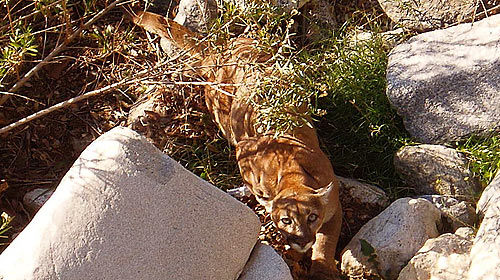
This was taken by Matthew Dickie, an engineer at the famous Jet Propulsion Laboratory in the hills near Pasadena, as he walked to work in the morning. Joe Mozingo wrote about it in today's LA Times:
On its east side, the Arroyo Seco — a stream that goes from dry to torrent depending on the weather — courses out of the mountains onto a sandy flood basin behind the Devil's Gate dam.A nice book on Coltrane's music, with a nice dose of music theory, but nothing too heavy:Because mountain lions and other wildlife routinely follow streams, the Arroyo Seco is a natural corridor, funneling a 32-square-mile watershed down to a narrow cut — where Dickie spotted the cougar last week.
Until last year, when the upper JPL property was fenced, large deer herds roamed the facility's open areas.
"Whenever you have a lot of deer, you are asking for lions," said Lt. Martin Wall of the California Department of Fish and Game. Two years ago, JPL employees found a partially eaten deer carcass under a trailer. "That was an eye-opener for them," Wall said.
JPL spokeswoman Veronica McGregor said all sorts of animals — bears, foxes, coyotes — roam onto the property. Generally, when security officers are notified of a mountain lion sighting, officials make an announcement over the public address system and post an advisory on JPL's internal website. McGregor said this has happened three times since 2004.
Joe Edmiston, director of the Santa Monica Mountains Conservancy, said such sightings should be celebrated. "I think it's the most wonderful thing in the world that we still live in a place that's not tamed, not domesticated," he said. "We should venerate the idea that this mountain lion is staring up at the engineers in their pocket protectors."
Fish and Game biologists estimate that there are 4,000 to 6,000 mountain lions in the state, from the redwoods to the Laguna Mountains on the Mexican border. One was killed by a vehicle on Angeles Forest Highway near Acton earlier this month.
This was the period when Coltrane occaisioned two of jazz's most famous punch lines. They both amount to the same thing. One came from Cannonball Adderly: "Once in a while, Miles might say, 'Why did you play so long, man?' and John would say 'I took that long to get it all in.'" The other seems to have no definite source. Coltrane says to Davis that he can't figure out a way to stop his solos. Davis retorts: "Why don't you try taking the horn out of your mouth?"
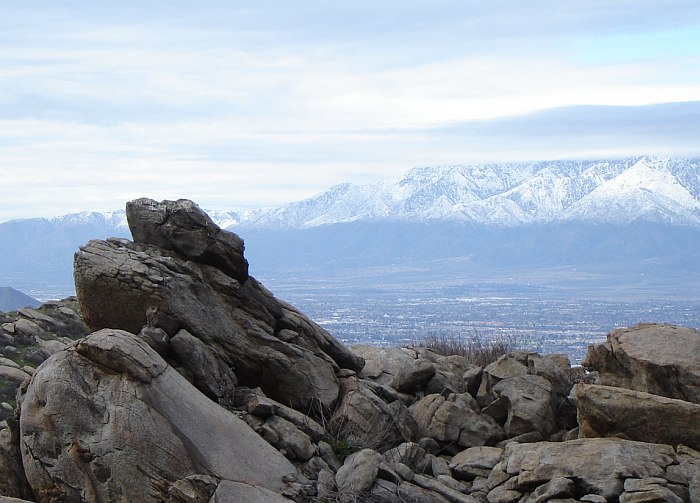
January 28, 2008
If you care about the Earth, please don't vote for Romney.
According to today's Los Angeles Times, Mitt Romney
recently "chided
McCain for cosponsoring legislation aimed at fighting global
warming, saying it would cost jobs and raise gasoline and electricity prices.
'Don't you understand, they don't call it American warming, they call it
global warming,' he shouted. 'We don't need to have
America have additional costs that the rest of the world doesn't bear.'"
It's also not called "Chinese warming", "Indian warming", etc. So,
by Romney's logic, I guess nobody should do anything about it.
We should all wait for someone else.
January 30, 2008
Just a note to myself: someday I want to buy a bamboo saxophone,
since they're a lot easier to play than the regular kind! With
only a few minutes practice I could make a sound on one in a market
in Greenwich last summer. Here's a place that sells them:
The water is rising. You try to rappel.
A rousing cheer for the boy in the well. - REM
© 2008 John Baez
baez@math.removethis.ucr.andthis.edu